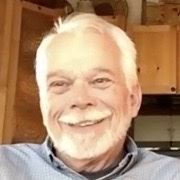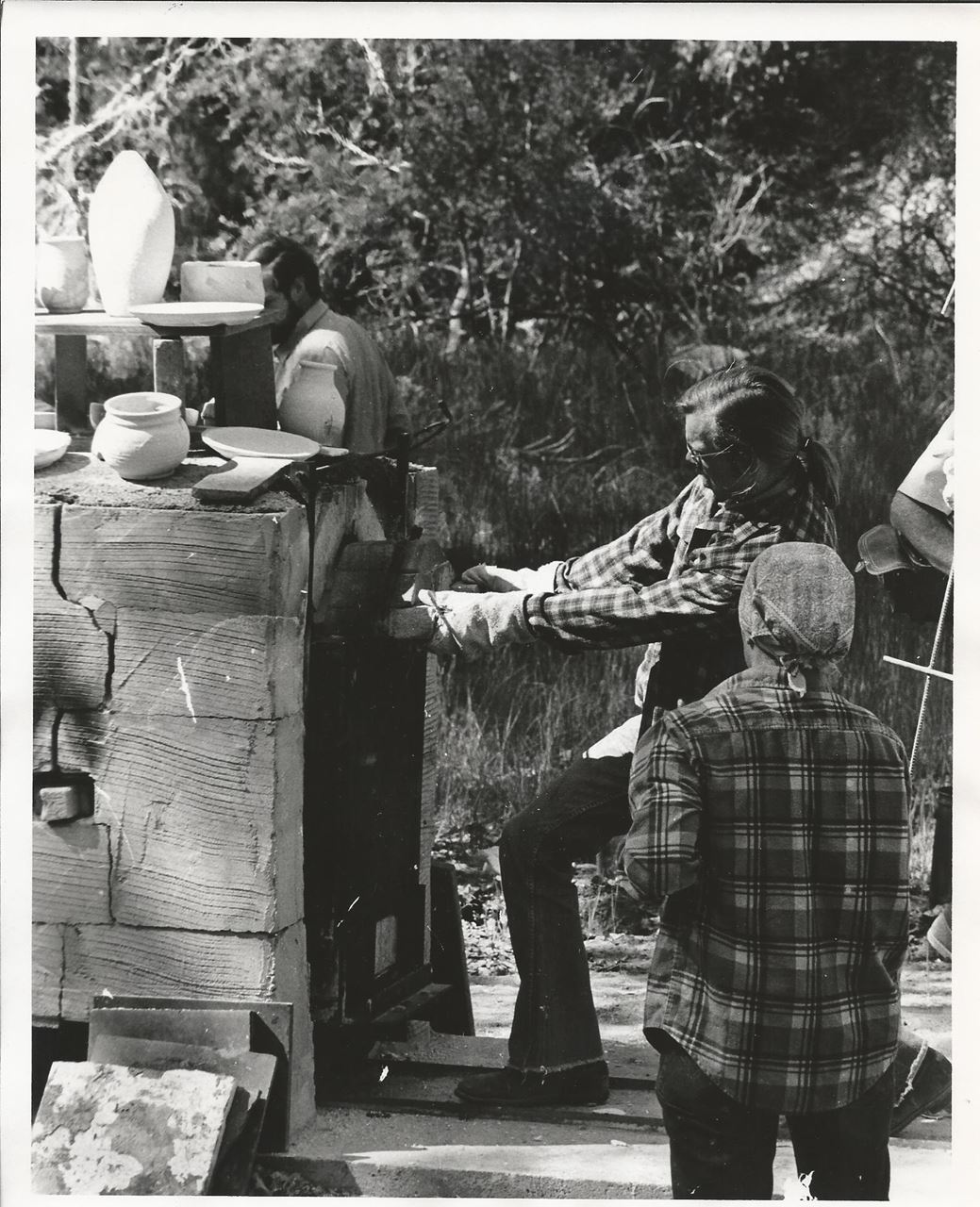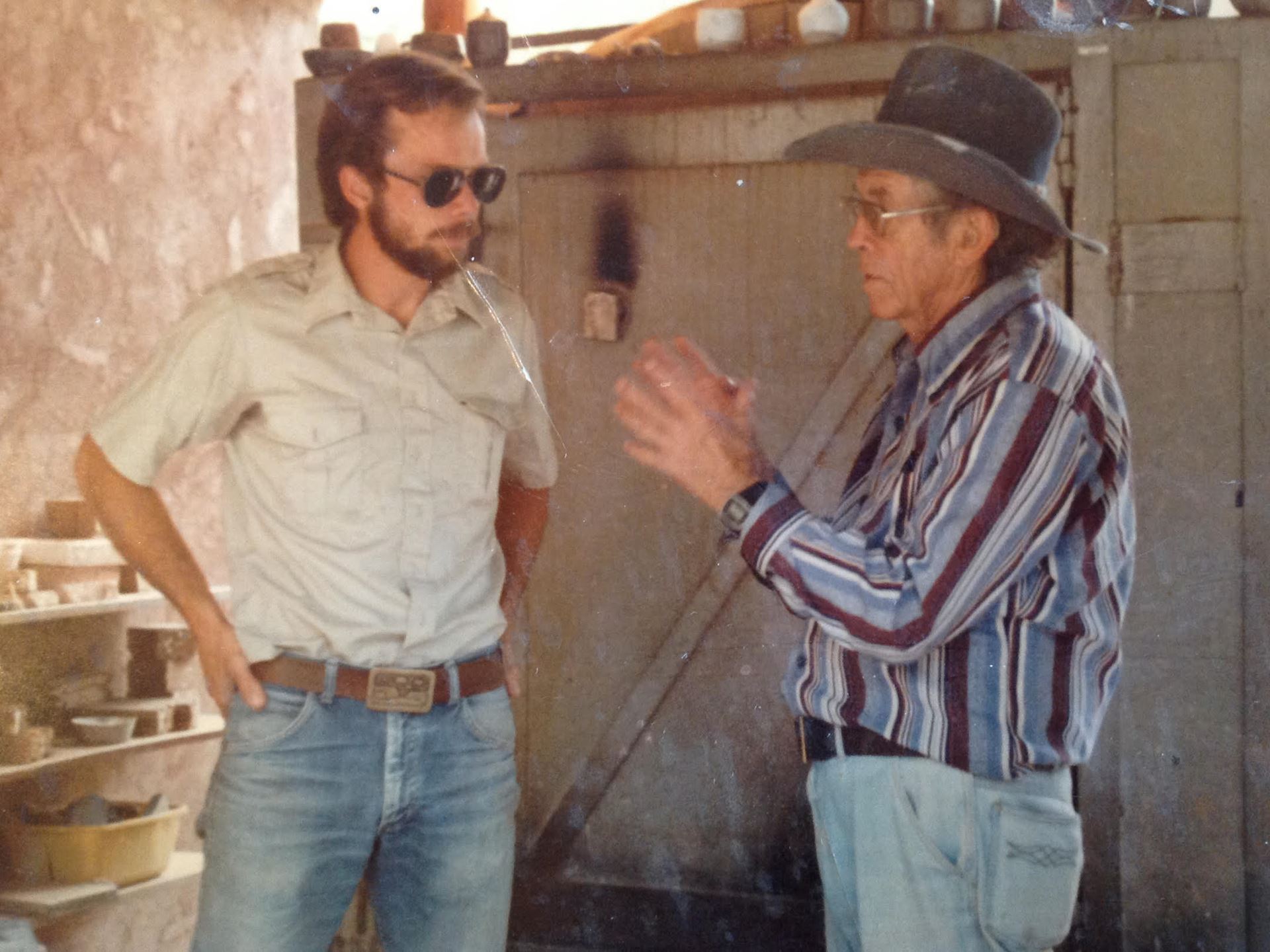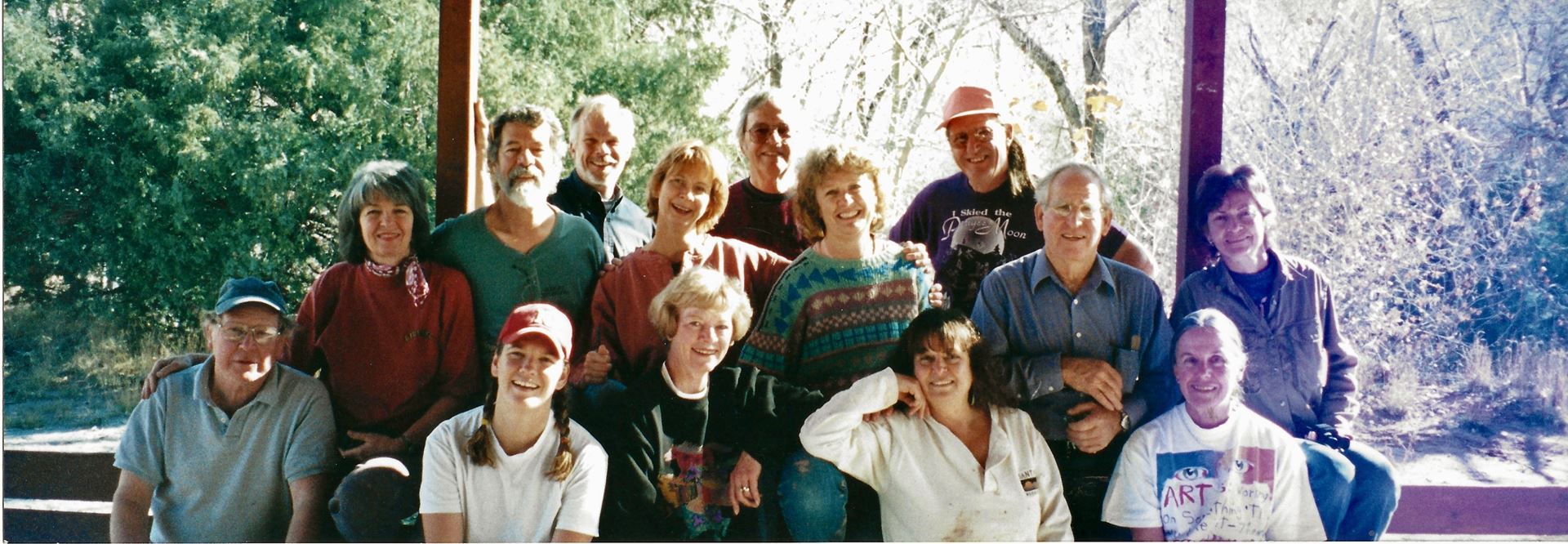 Part 1. Jim Kempes came to Ghost Ranch after graduating from Penn State University in 1972. He was granted Conscientious Objector (C.O.) status by the Philly draft board and sent to Ghost Ranch to do two years of 'alternate service.' There were 3 or 4 other C.O.’s at the ranch at that time. They worked every job on the ranch, wherever needed. After Jim completed his draft service, he remained in Abiquiu, helping to build the ranch ceramics program. By 1982, Ranch Director Jim Hall invited Jim to join the permanent staff and Jim worked as the Ghost Ranch ceramics coordinator until 2005. With wife Lesley (whom he met at Ghost Ranch) he raised two children and built a home near Abiquiu where they still live.
Part 1. Jim Kempes came to Ghost Ranch after graduating from Penn State University in 1972. He was granted Conscientious Objector (C.O.) status by the Philly draft board and sent to Ghost Ranch to do two years of 'alternate service.' There were 3 or 4 other C.O.’s at the ranch at that time. They worked every job on the ranch, wherever needed. After Jim completed his draft service, he remained in Abiquiu, helping to build the ranch ceramics program. By 1982, Ranch Director Jim Hall invited Jim to join the permanent staff and Jim worked as the Ghost Ranch ceramics coordinator until 2005. With wife Lesley (whom he met at Ghost Ranch) he raised two children and built a home near Abiquiu where they still live.
The Slip Trail (TST): Tell the story of how ceramics education programs started at Ghost Ranch and how you were involved.
Jim Kempes: Willard Spence, who had a passion for stoneware, raku, hand-building, crystalline glazes (a lifelong potter), moved to Taos from Indian Hills, Colorado around 1970. He got in touch with Ghost Ranch Director Jim Hall and made the connection to teach ceramics seminars. And somehow, the location below the parking area behind Dining Hall was chosen as the ceramics studio, Ray McCall and Willard put it down there. Because of my Conscientious Objector (C.O.) status during the Vietnam War, in January, 1973 I began a two-year work period at the Ranch. Then Jim Hall asked me to help Willard as part of my C.O. work commitment. I had taken ceramics in college. One of the first tasks Willard asked Jim Hall to do was build a structure to cover the kiln. Ray McCall, Director of Ranch Maintenance, was there to help build the structures around the kiln, as well as transport equipment. Ray was interested in that stuff, showed up to weld, lay bricks, help, and give support. Ray was very involved in those early years.
So, Willard came in, and decided to start it, and he had this idea of making these two trolley raku kilns. One over in Taos and one at Ghost Ranch. And the idea would be that we would move the trolley, [chuckling] it’s so heavy, from one site to the other site. And we did that! It was the big, heavy, weird thing with all the brick front, and it just leads into this chamber of the kiln. So, we took that over to his place in Taos. I went along with Ray. We watched the first firing. Then Willard taught a Raku seminar in Creative Arts, so I helped with that. (Creative Arts was one of the umbrella seminars.) And after having done that, I think it was Carl Soderberg wanted to include a Raku seminar in “Festival of Crafts.” I was just curious. Having done it just once, they put me teaching that. So that was pretty exciting. And we just slowly started building down there.

[Jim Kempes opening door of Raku trolley kiln circa 1970s. Photo from Poling-Kempes collection.]

[Jim Kempes and Willard Spence in front of cone 10 gas kiln circa 1980s. Photo from Poling-Kempes collection.]
That’s how it started, pretty much Willard, a lot of people were willing to help, you know, Jim Hall gave his support. To the point where we were going to build a high-fired stoneware kiln over there. We had the flat-bed truck up in Pueblo, CO, ready to load up hard fire brick to build this kiln. At the last second, we found out that an Office of Economic Opportunity program (Nixon canceled those programs) in Taos, had a high fire gas kiln they were willing to donate to the Ranch. So, the truck came back and went to Taos and we loaded up that kiln, brought it over. That was the start of that. Willard also donated an old electric kiln that he had had custom built, oh man it had 24 elements I think, and elements in the floor. It was a beast to fire, but it was running, free, a wonderful electric kiln. That’s how we started out. And then every year, Ray McCall would sort of extend the covering over the roof end, and we built the little shed to store materials in.
I think that’s about it. There’s a lot of names there. Carl Soderberg is the one who was in charge of Festival of Crafts. Jim Hall was supportive. You know, Creative Arts was the first seminar. Did you ever meet Ray Woods?
TST: Yeah! Would he have been from Philadelphia?
Jim Kempes: He was with the National Church in Philadelphia. David Brashear is the other guy. They were in charge of Creative Arts. And Carolyn Barford was an instructor, you know Carolyn.
TST: I remember first meeting Carolyn in the Dining Hall when I was a teenager still, in the early 70s. She was doing her illustration designs on t-shirts and would take whatever pen it was and draw it out, and fill it in with color on the shirt. It was a desired item that people were buying. Then she did paper prints and cards -- I bought a few! Later of course she transferred those prints to tiles. And then she taught Tile Painting, later, which I took one year.
Jim Kempes: I think she was on College Staff back in ‘68. She was one of the main art teachers in Creative Arts. When they put me helping Willard with that, I was just in over my head [chuckling]. But it was wonderful.
TST: Did the scope of the ceramics program follow a schedule? Please list and elaborate the courses.
Jim Kempes: Yes, there was a set schedule every summer. Creative Arts was usually the first one that would start. In the early days we did Raku in Creative Arts. Maybe somewhere in the 80s or 90s we switched and did Pit Fire with Creative Arts. And then after Creative Arts we would have Festival of Crafts, which was one week. And we did Raku with that. And then Festival of Crafts morphed into Festival of the Arts. And instead of one week it became two weeks. And the first week was Raku, and the second week was High-Fired, Cone 10 Stoneware. And then we added Folk Arts Festival to that, and we always did a Pit Fire with Folk Arts. Let’s see, that was the core at the beginning. In Folk Arts at some point, I switched over and I started doing Stone Carving in the Pole Barn, and I think we brought in Camilla Trujillo to do Pit Fire. So, there was still a clay element but I got to do stone a little bit instead of clay. Which again was inspired by Carolyn. I think Carolyn taught Stone Carving one of those first years during Creative Arts. I would be over doing pottery and would look over there and go, “You can carve stone?” And, just picked up a little scrap and started, yeah, just jumped into that. Those were the “Creative Arts.”
We added a lot of different things, we added Crystalline Glazes at the end of the summer. That was Willard’s thing, his passion, to work with crystalline glazes and his old electric kiln was perfect for that. At another point, we added Clint Swink / Mesa Verde Black on White. That’s that story of me seeing that he was giving a talk at the Forest Service in Santa Fe. So, I scooted in just to hear that talk, because you are surrounded by potsherds here, you know it was pretty cool to hear him talk about that. And we contacted him to see if he would be willing to teach. Yeah, we would end the summer with the Mesa Verde Black on White.
Also, if you remember, that every spring we would start off with the Potters Association. The Potters group would come in and do a workshop with nationally and internationally known potters and it was always a treat for me. I would hang around and fire things and do some grunt labor, but I got to learn a whole lot. And that started with, I think it was, Juan Quezada. Did you see that news that he just passed away? Akio Takamori, you remember that workshop? Did great slab work, figurative lines. Jim Romberg, Raku. The Potters brought him in. Another one was Rudy Autio. Betty Colbert who taught tile-making. I can’t remember half of the potters that they brought in. Every year from tiles to sculpture to crazy, big wheel work. That was always the treat, start off the summer, to get Pot Hollow ready for the summer with that NM Potters course. Eddie Dominguez had a great one there. He lived in the area for a while. There was good ceramics – you could really learn a lot. And, Potters would always show their slide shows, and so you’d see other peoples’ work. Very supportive, very nice group.

[NMPCA workshop early 2000s. Front Row: unknown, unknown, Pat Stalgren, unknown, Penne Roberts. Middle Row: Lynn Eby, Gary Carlson, unknown, unknown, unknown, Elaine Biery. Back Row: Jim Kempes, Jack Roberts, Phil Green. Photo from Gary Carlson.]
And then the rest of the year still had a rhythm too. We had Elder Hostel. Elder Hostels came in with Chuck and Ginny Graham, and Aubrey Owen. They sort of set that up. Then that morphed on to Bill and Carol Mackey running those. And we would do Pit Fire in May and education about some of the Native American Potters in the area. That was always great. We would be up in Piñon for that. And then there was the “Jan Term” college course. You know some colleges have 3 weeks in January off, and they have an interim course that you could go and take, and Aubrey was the one who set that up. We had DePauw, and Austin College in Sherman TX, and a few that I’m not remembering. We would get 40-60 college students for that period. They would do Black and White Photography, and Enza Quardanelli started out with Batik, another friend of Willard’s. Cordelia Coronado came in and taught weaving with her daughter, Teresa. So that was total immersion, for three weeks. We would have a couple weeks of wheel work and hand-building inside. Then we would switch to firing and we did raku, we did stoneware, and while those pots were all being fired, we did Pit Fire. Those kids, we worked them hard. Students would go their separate ways in the morning, to their separate studios. Jan Term was a great offer. Florence Hawley Ellis came up and taught Archaeology, too. There was also Solar Energy.
TST: Yeah, I hear that. What a year. My gosh so you ended up having February and March was that the only time you had off?
Jim Kempes: Fall and spring were good times. Elder Hostel would fit in here and there Fall and Spring pretty wide open for me to do my own work, which just worked great for me.
We did have a bronze casting class too that was in Festival. We would use that Raku kiln to burn off the wax out of the “investments” (another word for "mold”). I believe that was Ed Vega who came up from Albuquerque. We did that, one or two years. And it was a blast. So, Pot Hollow was always used.
-- Interview continues in "Part 2."


